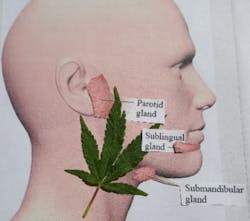Wreck victim turns to medical pot, advocates xerostomia treatment
By Diane Kaufman, RDH
My dental hygiene education started as a student at Indiana School of Dentistry (class of 1988). However, my career has been based in Fort Collins, Colorado. After years of providing care to my dental patients, my career ended abruptly. Last year while driving 80 miles per hour on a Colorado interstate, I was hit head-on by a road rage driver going the wrong way.
Dealing with my injuries and losing the ability to permanently continue to care for my patients, I was in a very dark place. After experiencing the negative side effects of multiple pharmaceuticals, I started using medical marijuana. I am so grateful that I live in Colorado, where marijuana can be legally consumed both medically and recreationally.
The positive efficacy of using medical marijuana, for me personally, has been extremely beneficial. However, one major exception has been xerostomia, more commonly called “cotton mouth” by marijuana consumers.
As a dental hygienist, I know that xerostomia, or "cotton mouth," is a prolific problem. The cycle of dental caries associated with xerostomia is of special concern with our patients who consume marijuana. After a patient consumes marijuana, the patient may experience xerostomia. Many of these patients experience complete dryness of the dentition. Coupled with the intake of foods high in carbohydrates ("munchies") and the lack of anticariogenic actions of normal saliva flow, tooth decay will progress much more rapidly with patients who consume marijuana than with patients who do not consume it.
We all learned in dental hygiene school that, within five minutes of consuming foods high in carbohydrates, the acidity in the mouth drops to a pH of 5.5. We also learned that this critical pH greatly increases the chances of tooth caries. Areas of concern with marijuana consumers are, in particular cervical and root surface caries.
In patients with a normal salivary flow rate, the pH will be neutralized in about 20 minutes. However, patients who consume marijuana will often take twice as long to neutralize mouth acid. As saliva acts as a buffer and helps to prevent demineralization of teeth, it is imperative that we communicate the detrimental consequences of xerostomia that patients experience who consume marijuana.
We now have science behind marijuana’s “cotton mouth.” A group of Argentinian scientists from the University of Buenos Aires found that marijuana can dry out the mouth by binding to cannabinoid receptors found in salivary glands.
Surprisingly, we all have cannabinoid receptors. These receptors act as binding sites for both plant and human cannabinoids and are found in many parts of the body. One of those areas are the glands where saliva is produced. Both types of cannabinoid receptors (CB1 and CB2) are present in the submandibular glands. This is the area where a pair of glands are located beneath the floor of the mouth. They are responsible for 70% of our saliva.
Molecules of tetrahydrocannabinol, often referred to as THC, is found in marijuana. The THC is responsible for the main, mind-altering ingredient found in the marijuana plant. According to the National Institute on Drug Abuse, THC acts much like the cannabinoid chemicals made naturally by the body. When a cannabinoid like THC binds to its receptor, the submandibular glands stop receiving messages from the parasympathetic nervous system telling them to produce saliva.
Although researchers have yet to make an attempt at solving the temporary “cotton mouth” that affects marijuana consumers, they are looking at ways to use this information to treat other problems associated with altered saliva production. By targeting cannabinoid receptors, scientists may one day be able to increase or decrease saliva levels in patients who suffer from a variety of conditions known to cause a permanent state of xerostomia.
As dental professionals, it is up to us to meet the new demands of educating our patients on how marijuana can affect their dental health. We should meet the needs of our patients without condemnation or perceived judgment. Marijuana use is not just for “potheads.” In this new frontier of marijuana use, new studies are confirming the medical benefits of consuming marijuana.
As dental hygienists, we should stress the use of supplemental topical fluorides to help prevent caries formation. The patient’s oral hygiene care at home is more important than ever before. I use and recommend a sonic electric toothbrush. If your patient is not flossing, talk to him or her about using a water flosser. Have the patient consider drinking water or chewing sugarless gum after consuming marijuana.
We now have evidence based information on why marijuana consumers experience xerostomia. With this knowledge we must continue to educate ourselves and our patients.
Diane Kaufman, RDH, is the owner of Organic Harvest Hands in Fort Collins, CO. Organic Harvest Hands is an all organic hand cleaner and moisturizer. She can be contacted at [email protected].
